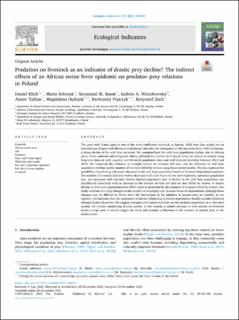| dc.contributor.author | Klich, Daniel | |
| dc.contributor.author | Sobczuk, Maria | |
| dc.contributor.author | Basak, Sayantani M. | |
| dc.contributor.author | Wierzbowska, Izabela A. | |
| dc.contributor.author | Tallian, Aimee Grace | |
| dc.contributor.author | Hędrzak, Magdalena | |
| dc.contributor.author | Popczyk, Bartłomiej | |
| dc.contributor.author | Żoch, Krzysztof | |
| dc.coverage.spatial | Europe | en_US |
| dc.date.accessioned | 2022-03-25T12:15:53Z | |
| dc.date.available | 2022-03-25T12:15:53Z | |
| dc.date.created | 2021-12-23T12:27:15Z | |
| dc.date.issued | 2021 | |
| dc.identifier.citation | Ecological Indicators. 2021, 133 1-11. | en_US |
| dc.identifier.issn | 1470-160X | |
| dc.identifier.uri | https://hdl.handle.net/11250/2987642 | |
| dc.description.abstract | ABSTRACT The gray wolf (Canis lupus) is one of the most conflictual mammals in Europe. Wild boar (Sus scrofa) are an essential part of gray wolf diet in central Europe, but after the emergence of African swine fever (ASF) in Europe, a sharp decline of the wild boar occurred. We examined how the wild boar population decline, due to African swine fever outbreak and mitigation efforts, affected the number of livestock killed by wolves in Poland using long-term data on wild ungulate and livestock population sizes and wolf-induced mortality between 2013 and 2019. We examined the influence of multiple factors on livestock kill rate, and the influence of wild boar population declines on the number of Cervidae killed by wolves using linear mixed models. We also explored the possibility of predicting a dramatic decrease in the wild boar population based on livestock depredation patterns. The number of livestock killed by wolves decreased with wild boar and roe deer (Capreolus capreolus) population size, and increased with red deer (Cervus elaphus) population size. A decline in the wild boar population was significantly correlated with an increase in the number of both red and roe deer killed by wolves. A drastic decline of wild boar population (over 30%) could be predicted by the numbers of livestock killed by wolves. Our study confirms that large changes in the number of naturl prey can increase livestock depredation, although these changes may be difficult to detect when the fluctuations in the numbers of natural prey are smaller. In our opinion, this indicates that the assessment of factors influencing livestock depredation should consider historical changes in prey dynamics. We suggest managers and conservationists use the predator population as a ’first alert system’ for indirect monitoring of prey species. In this system, a sudden increase in wolf attacks on livestock across a large area of should trigger an alarm and prompt verification of the numb African swine fever ASF Epidemic Gray wolf (Canis lupus) Wild boar (Sus scrofa) Roe deer (Capreolus capreolus) Red deer (Cervus elaphus) Livestock er of natural prey in the environment. | en_US |
| dc.language.iso | eng | en_US |
| dc.rights | Attribution-NonCommercial-NoDerivatives 4.0 Internasjonal | * |
| dc.rights.uri | http://creativecommons.org/licenses/by-nc-nd/4.0/deed.no | * |
| dc.title | Predation on livestock as an indicator of drastic prey decline? The indirect effects of an African swine fever epidemic on predator–prey relations in Poland | en_US |
| dc.type | Peer reviewed | en_US |
| dc.type | Journal article | en_US |
| dc.description.version | publishedVersion | en_US |
| dc.rights.holder | © 2021 The Authors | en_US |
| dc.subject.nsi | VDP::Zoologiske og botaniske fag: 480 | en_US |
| dc.subject.nsi | VDP::Zoology and botany: 480 | en_US |
| dc.source.pagenumber | 1-11 | en_US |
| dc.source.volume | 133 | en_US |
| dc.source.journal | Ecological Indicators | en_US |
| dc.identifier.doi | 10.1016/j.ecolind.2021.108419 | |
| dc.identifier.cristin | 1971732 | |
| dc.source.articlenumber | 108419 | en_US |
| cristin.ispublished | true | |
| cristin.fulltext | original | |
| cristin.qualitycode | 1 | |

